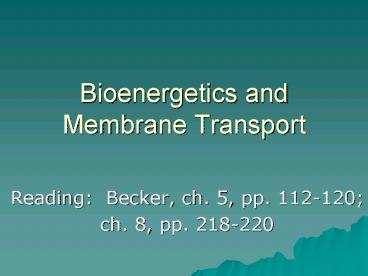Bioenergetics and Membrane Transport - PowerPoint PPT Presentation
1 / 18
Title:
Bioenergetics and Membrane Transport
Description:
8, pp. 218-220. Energy. The ability to do work. The ability to cause ... where T is temp in degrees Kelvin (K = C 273) Spontaneous ... Vm = membrane ... – PowerPoint PPT presentation
Number of Views:185
Avg rating:3.0/5.0
Title: Bioenergetics and Membrane Transport
1
Bioenergetics and Membrane Transport
- Reading Becker, ch. 5, pp. 112-120
- ch. 8, pp. 218-220
2
Energy
- The ability to do work
- The ability to cause change
- Types of change
- Change in solute across a membrane
- Change in ion and charge across a membrane
- Changes in chemical structure (making and
breaking bonds) - Changes in location of cells or subcellular
structures (movement) - Changes in temperature (production of heat)
- Production of light (bioluminescence)
3
Energy
- Measured in units of calories (cal)
- 1 cal amount of energy required to raise temp
of 1 g of H2O 1ºC at a pressure of 1 atmosphere - Also expressed as joules
- 1 cal 4.184 joules
4
The Cell is an Open System
- Can exchange energy with its surroundings
5
First Law of Thermodynamics(Law of Conservation
of Energy)
- Energy can be neither created nor destroyed, but
can be converted from one form to another - For a closed system (such as the universe as a
whole) - Total energy in all forms is the same before
and after any reaction. - For an open system (such as the cell)
- Energy out energy in energy stored
- OR
- Energy stored energy in energy out
6
Change in Internal Energy (DE)
- Energy stored energy in energy out
- Energy stored Internal energy E
- DE change in stored energy after a process
has occurred - DE Eproducts Ereactants
7
Change in Heat (DH)
- Difference in stored energy (DE) before and after
a biological reaction is almost always due to a
change in heat - During a biological reaction, heat is either lost
or consumed - Change in stored energy can be approximated as
the change in heat - DE DH
8
Change in Heat (DH)
- Heat content is known as enthalpy
- DH the change in enthalpy accompanying a
biological reaction - DH Hproducts Hreactants
9
Change in Heat (DH)
- DH Hproducts Hreactants
- If Hproducts lt Hreactants, energy has been lost
in the form of heat - negative DH (decrease in enthalpy)
- exothermic reaction
- If Hproducts gt Hreactants, energy has been taken
up by products in the form of heat - positive DH (increase in enthalpy)
- endothermic reaction
10
Change in Heat (DH)
11
The Second Law of Thermodynamics
- In every physical or chemical change, the
universe tends toward greater disorder or
randomness - The system may tend toward more order, but the
surroundings become more disordered because of
the input of energy required from outside
12
Entropy
- Entropy a measure of randomness or disorder
- S
- Change in entropy DS
13
Entropy
- For every biological reaction, entropy in the
universe increases - DSuniverse is positive
- Within a system, entropy can either increase
(DS), decrease (-DS), or stay the same as the
result of a reaction
14
Free Energy
- Free Energy a measure of whether or not a
biological reaction will occur spontaneously - i.e., requires energy (non-spontaneous) or does
not require energy (spontaneous) - G
- Change in Free Energy DG
- A measure of energy released or utilized in a
biological reaction
15
Change in Free Energy
- DG DH TDS,
- where T is temp in degrees Kelvin (K ºC 273)
- Spontaneous reactions
- DGsystem lt 0
- Exergonic or energy-yielding
- Non-spontaneous reactions
- DGsystem gt 0
- Endergonic or energy-requiring
16
DG and Transport Across Membranes
- Uncharged solutes, S
- Uncharged solutes will cross membranes down their
concentration gradients by either simple or
facilitated diffusion, with rate of diffusion
dependent upon the solutes size and polarity and
the presence of specific transport proteins - Uncharged solutes can be pumped across membranes
up their concentration gradients by active
transport, dependent on the presence of specific
pumps
17
DG and Transport Across Membranes
- For uncharged solutes, S
- DGinward RTlnSinside
- Soutside
- DGoutward RTlnSoutside
- Sinside
- Where R 1.987 cal/mol-K
- T absolute temp in K
- S is expressed in mol/L
18
DG and Transport Across Membranes
- Charged solutes (ions) are affected by both the
concentration gradient and the electrochemical
gradient - DGinward RTlnSinside zFVm
- Soutside
- Where R 1.987 cal/mol-K
- T absolute temp in K
- S is expressed in mol/L
- z the charge on the ion
- F 23,062 cal/mol-K
- Vm membrane potential in volts
- Membrane potential the voltage across a
membrane that is caused by the unequal
distribution of charge across the membrane - For most animal cells, membrane potential is
between -60 and -90 mV































